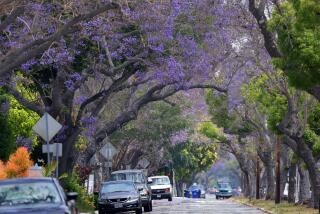High-Tech Companies See Blessing in Disguise
- Share via
As he glided past the water-squirting elephants, lush faux palm trees and prowling tigers at Disneyland, Al Landini had an epiphany.
The Los Angeles zoning administrator had grown weary of trying to balance the concerns of homeowners against the rights of cellular phone providers to erect their towering antennas around the city.
But as he gazed upon the artificial fantasy world of Disneyland’s Jungle Cruise, Landini saw an answer.
“Why can’t they make the antennas look like palm trees?”
It turned out they could. And they have.
Just this year, two cellular phone antennas disguised as palm trees have sprouted up in Winnetka in the San Fernando Valley. The cloaking devices are just one of the many ways that savvy business types are exploiting nature’s beauty to mask technology.
Some are embracing the technique to avoid NIMBY battles, while others do it simply to create a mood.
“What we are doing intuitively here is to hide raw urban edifices to bring comfort to the population,” Landini said. “Millions of people want cell phones; at the same time, they want a softer-looking city.”
GTE has installed hundreds of rock facades throughout Ventura County to hide recently installed digital cable boxes. And in Westlake and Northridge, visitors of outdoor shopping centers enjoy music beamed at them from speakers shaped as rocks, which are also expected to crop up at shopping centers planned for Calabasas and the Farmers Market in Los Angeles.
As the trend spreads across the country, it is fueling the creation of an array of functional flora. A 35-foot cellular phone antenna dressed up as a Saguaro cactus recently made its debut in the Arizona desert.
In Laguna Beach, two lighthouse replicas camouflage a sewage treatment plant that operated until 1983, City Manager Kenneth C. Frank said.
The buildings along Laguna Canyon Road were part of the plant’s 1930s design. The larger of the two covered the digester, where sewage was heated before disposal, and the “mini-lighthouse” fit over the vent that once spouted methane gas.
In 1996, Seal Beach decided to use its beloved City Hall clock tower as a site for Pacific Bell’s cellular telephone relay equipment. The equipment was tucked inside and painted to match the tower’s exterior.
For three years, the obelisk at Edwards Irvine Spectrum has housed AT&T;’s cell phone apparatus. “It is a landmark of sorts,” said Paul Brady, Irvine’s city manager. “Everybody’s been pleased with its appearance. People speak very highly of it.” The flurry of new construction is partially the result of the 1996 Telecommunications Reform Act. The federal law strictly prohibits local governments from shutting out companies that want to provide wireless communication services in an area and from banning cellular phone towers on the grounds that their emissions are unsafe.
But it allows cities to regulate the way the antennas look, and with new companies racing to build their systems, available sites are becoming scarce. Nationwide, there were 50,000 antenna sites as of last year, and that figure is expected to more than double by 2006.
Landini whipped up the palm tree concept about three years ago after growing tired of meeting after public meeting pitting disgruntled residents against cellular phone providers over proposed sites. Landini mentioned his disguise idea to consultants employed by the cellular phone industry, who began researching the possibility.
“Whether I’m the father of that, I don’t know. But to me, it’s a way of reducing urban stress,” he said. “What makes your day stressful isn’t palm trees. It’s the hard edges.”
Perhaps it’s not surprising that one of the companies specializing in prettifying cellular equipment has done work for Disney, Universal Studios, Sea World and the recently completed Long Beach Aquarium. Enter the Arizona-based Larson Co., which teamed up with Nebraska-based Valmont Industries.
Valmont manufactures steel poles and ships them to Larson’s utility camouflage division, where artists cover them with composite bark and attach fake branches or fronds to the poles to create realistic-looking palms, pines, evergreens and cactus.
But “stealthing,” as it’s known in the industry, can be expensive, with a single 100-foot pole disguised as a tree costing $80,000 or more, compared with $25,000 to $30,000 for a plain pole.
The nation’s churches also have been singled out by the cellular phone industry as particularly gracious hosts for their antennas.
The technology is often hidden in giant crosses or specially built steeples. Monthly rents are paid to the churches, which use the money for social causes.
“We’ve found God,” said Tim Ayers, spokesman for the Cellular Telecommunications Industry Assn. “We’re building more church steeples than any other industry in history.”
More to Read
Inside the business of entertainment
The Wide Shot brings you news, analysis and insights on everything from streaming wars to production — and what it all means for the future.
You may occasionally receive promotional content from the Los Angeles Times.










